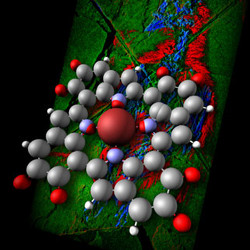Palaeometallomics
The dilute elemental inventory that distinct tissue types exhibit (both living and extinct organisms) can provide information on both the biology and physiology of Life.

Here we investigate the preservation of compounds that can be linked to endogenous soft-tissues, their breakdown products or affiliated elemental inventories. This allows the identification of the rate law dependencies for soft-tissue breakdown reactions under various lithological conditions and thus isolates the conditions that may lead to exceptional preservation in deep time. We propose that the presence of specific trace-metal inventories may act to aid the preservation of soft-tissue fossils, and thus a key stream of research for the group is to investigate how the presence of specific elements and compounds affects the fossilisation process. We also seek to extend our current database to cover the preservation and detection of discrete soft-tissue biomarkers, since this will improve our ability to resolve further aspects of biochemistry and possibly physiology. We have named this particular research direction, the ‘palaeometallome’. This research takes full advantage of the high sensitivity, but decimetre scale elemental mapping capability, that the Synchrotron Rapid Scanning X-Ray Fluorescence (SRS-XRF) technique provides at SSRL. The Natural Environmental Research Council (NERC, UK) recently awarded our group a major grant to further explore this research.
Our research focus has fallen upon the colour patterns preserved in ancient organisms, which is an important factor in an organism’s biology and natural selection. For example, colouration is known to indicate sexual dimorphism and can even indicate the habitat in which an organism resides. Our recent contributions to this area of research have uniquely employed synchrotron x-ray techniques to study several fossil and extant organisms including reptile skin (50 Million year age [Mya]) and feathers in the pivotal early bird Confuciusornis sanctus (~120 Mya) and the iconic Archaeopteryx lithographica (~150 Mya), in order to map and characterize the preserved chemical residues of melanin pigments (responsible for dark black/brown and reddish hues). A number of biologically important metal ions (such as Ca2+, Cu2+, Co2+, and Zn2+) are chelated by and affect the chemical properties of melanin so that trace metal distributions help constrain the location and concentration of melanin in extant feathers. Supported by many other analytical techniques, synchrotron results show that trace metals such as copper are present in fossil soft-tissues as organometallic compounds most likely derived from original eumelanin pigment (the type of melanin responsible for dark black/brown colouration). EXAFS analyses indicated that the Cu-coordination chemistry in the fossils is predominantly an organic molecular compound with coordination chemistry similar to Cu in natural eumelanin. The planar atoms of the C. sanctus Cu-coordination complex superimposed onto a recently optimized computational model of melanin confirm this result. The distribution of these compounds provides a long-lived biomarker of eumelanin presence and density within a range of extinct organisms.
Lead researchers
- Prof. Roy Wogelius
- Prof. Phil Manning
- Dr. Uwe Bergmann
- Prof. William Sellers
- Dr. Bart van Dongen
- Dr. Victoria Egerton
- Peter Larson
- Dr Nick Edwards



